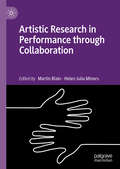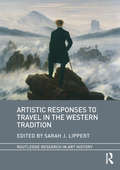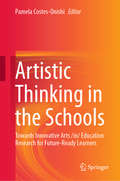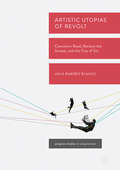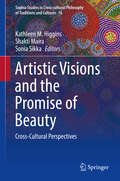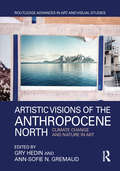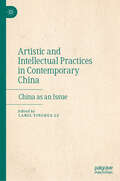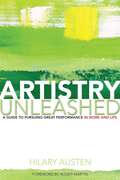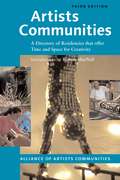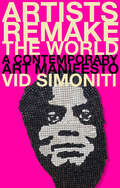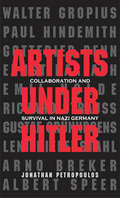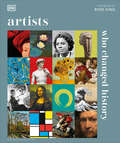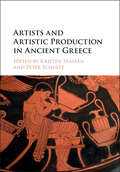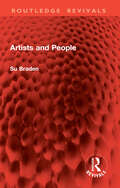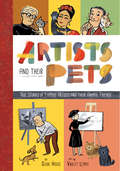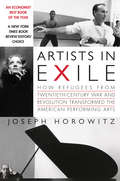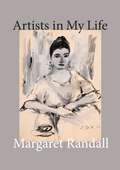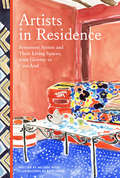- Table View
- List View
Artistic Plants and Flowers (Dover Fine Art, History of Art)
by M. P. VerneuilFrom one of the biggest names in Art Nouveau design comes this splendid visual encyclopedia of superior artistic studies of plants and flowers. Its 120 images were selected from a rare, century-old, four-volume set of botanical illustrations. Cherry blossoms, clematis, crown imperial, and other specimens appear side by side in full-page plates that contrast magnificent color renditions with meticulous black-and-white drawings.A leading designer in the Art Nouveau movement, M. P. Verneuil was particularly interested in the decorative potential of flowers, and he created countless realistic and imaginative floral patterns. In this collection, he spotlights the work of such popular artists as Alphonse Mucha, M. Méheut, and other distinguished illustrators. Captions identify each image. A very useful, wide-ranging reference, this volume will delight artists and lovers of botanical illustration.
Artistic Research in Performance through Collaboration
by Helen Julia Minors Martin BlainThis volume explores the issue of collaboration: an issue at the centre of Performance Arts Research. It is explored here through the different practices in music, dance, drama, fine art, installation art, digital media or other performance arts. Collaborative processes are seen to develop as it occurs between academic researchers in the creative arts and professional practitioners in commercial organisations in the creative arts industries (and beyond), as well as focusing attention and understanding on the tacit/implicit dimensions of working across different media.
Artistic Responses to Travel in the Western Tradition (Routledge Research in Art History)
by Sarah J. LippertIn an era when ease of travel is greater than ever, it is also easy to overlook the degree to which voyages of the body – and mind – have generated an outpouring of artistry and creativity throughout the ages. Exploration of new lands and sensations is a fundamental human experience. This volume in turn provides a stimulating and adventurous exploration of the theme of travel from an art-historical perspective. Topical regions are covered ranging from the Grand Tour and colonialism to the travels of Hadrian in ancient times and Georgia O’Keeffe’s journey to the Andes; from Vasari’s Neoplatonic voyages to photographing nineteenth-century Japan. The scholars assembled consider both imaginary travel, as well as factual or embellished documentation of voyages. The essays are far-reaching spatially and temporally, but all relate to how art has documented the theme of travel in varying media across time and as illustrated and described by writers, artists, and illustrators. The scope of this volume is far-reaching both chronologically and conceptually, thereby appropriately documenting the universality of the theme to human experience.
Artistic Thinking in the Schools: Towards Innovative Arts /in/ Education Research for Future-Ready Learners
by Pamela Costes-OnishiThis book examines current context-specific trends and developments in empirical research on arts education and arts in education, in order to evaluate and create responsive approaches to future global challenges. By highlighting the centrality of the arts in advancing future orientations in education, it offers a timely and valuable contribution to educational issues on preparing teachers and learners for the increasingly complex societal dynamics and unpredictable global economy.
Artistic Utopias of Revolt: Claremont Road, Reclaim the Streets, and the City of Sol (Palgrave Studies in Utopianism)
by Julia Ramírez BlancoThis book analyses the aesthetic and utopian dimensions of various activist social movements in Western Europe since 1989. Through a series of case studies, it demonstrates how dreams of a better society have manifested themselves in contexts of political confrontation, and how artistic forms have provided a language to express the collective desire for social change.<p><p> The study begins with the 1993 occupation of Claremont Road in east London, an attempt to prevent the demolition of homes to make room for a new motorway. In a squatted row of houses, all available space was transformed and filled with elements that were both aesthetic and defensive – so when the authorities arrived to evict the protestors, sculptures were turned into barricades. At the end of the decade, this kind of performative celebration merged with the practices of the antiglobalisation movement, where activists staged spectacular parallel events alongside the global elite’s international meetings. As this book shows, social movements try to erase the distance that separates reality and political desire, turning ordinary people into creators of utopias. Squatted houses, carnivalesque street parties, counter-summits, and camps in central squares, all create a physical place of these utopian visions
Artistic Visions and the Promise of Beauty: Cross-Cultural Perspectives (Sophia Studies in Cross-cultural Philosophy of Traditions and Cultures #16)
by Sonia Sikka Kathleen M. Higgins Shakti MairaThis volume examines the motives behind rejections of beauty often found within contemporary art practice, where much critically acclaimed art is deliberately ugly and alienating. It reflects on the nature and value of beauty, asking whether beauty still has a future in art and what role it can play in our lives generally. The volume discusses the possible "end of art," what art is, and the relation between art and beauty beyond their historically Western horizons to include perspectives from Asia. The individual chapters address a number of interrelated issues, including: art, beauty and the sacred; beauty as a source of joy and consolation; beauty as a bridge between the natural and the human; beauty and the human form; the role of curatorial practice in defining art; order and creativity; and the distinction between art and craft. The volume offers a valuable addition to cross-cultural dialogue and, in particular, to the sparse literature on art and beauty in comparative context. It demonstrates the relevance of the rich tradition of Asian aesthetics and the vibrant practices of contemporary art in Asia to Western discussions about the future of art and the role of beauty.
Artistic Visions of the Anthropocene North: Climate Change and Nature in Art (Routledge Advances in Art and Visual Studies)
by Gry Hedin Ann-Sofie N. GremaudIn the era of the Anthropocene, artists and scientists are facing a new paradigm in their attempts to represent nature. Seven chapters, which focus on art from 1780 to the present that engages with Nordic landscapes, argue that a number of artists in this period work in the intersection between art, science, and media technologies to examine the human impact on these landscapes and question the blurred boundaries between nature and the human. Canadian artists such as Lawren Harris and Geronimo Inutiq are considered alongside artists from Scandinavia and Iceland such as J.C. Dahl, Eija-Liisa Ahtila, Toril Johannessen, and Björk.
Artistic and Intellectual Practices in Contemporary China: China as an Issue
by Carol Yinghua LuThis edited volume is the first internationally available English translation of key lectures and essays delivered at Beijing’s Inside Out Art Museum over the past decade. The book elevates a chorus of voices from domestic and international intellectuals, artists, curators, and historians in a dialogue that reframes Chinese art from 1949 to the present.Part I offers critical academic complications of the story of Chinese art from the 1950s to the present as one singularly defined and stifled by political revolution. It traces important continuities and early examples of contemporary art practice to the Party’s birth and consolidation of power from the 1920s onwards. It relates the formation of contemporary art to the historical course of intellectual practice in China from 1949. Part II proposes China as an “issue” requiring historical interrogation rather than an inviolable entity. It questions the efficacy of “Asia” as a term, presents case studies of independentpublishers that challenged tightly crafted historical narratives, and wraps up with incisive reflections on the challenges confronting creatives and historians in China today.With chapters ranging from peer-reviewed scholarship to cuttingly humorous personal anecdotes, its contributing authors give rare, first-hand accounts of navigating pertinent historical and current situations, including censorship, China’s il/liberalism, and COVID-19. This book offers readers an ear to heretofore closed-door conversations in leading modern and contemporary art spaces.
Artistry Unleashed
by Hilary Austen University of TorontoArtistry Unleashed is about working and living at the edge of what you know and beyond. Surprise, uncertainty, ambiguity, intensity, and change are all disruptive forces that we often avoid or fear. Yet they are the essential origin of both creativity and great performance.Imagine if you could make effective progress with no clear plan or destination in view; if you could achieve excellence without sacrificing creativity; if you could invest passion even as you apply reason and intelligence. Learn how artistry, when allowed to escape studio walls, can help painters, CEOs, athletes, scientists, chefs, and you to achieve these powerful capabilities. Artistry Unleashed provides original and practical tools to transform what we think about artistry's role in professions, in organizations, in education, and, most importantly, in everyday life. Artistry Unleashed reveals the unique features of artistic work in any field: enigmatic problems; qualitative intelligence; cognitive emotions; downstream and upstream learning; and your personal knowledge system.
Artists At Work
by Bernard ChaetChaet explores the relationship between an artist's materials and technique, and the forms in which he expresses his vision. He shows that technique and vision are inseparable.
Artists Communities: A Directory of Residencies that Offer time and Space for Creativity (Artists Communities: A Directory Of Residences That Offer Time And Spa Ser.)
by Robert Macneil The Alliance of Artists' CommunitiesThe bible of creative residency programs returns, with fresh information and new features for artists of all disciplines. More than 300 programs worldwide are described, with 95 leading communities featured in two-page spreads with photographs. The user-friendly layout allows for quick scans of facility descriptions, deadlines, fees, selection processes, odds of acceptance, special programs, and more. For artists seeking to boost their creativity in a fresh and inspiring setting, Artists' Communities is the definitive sourcebook.
Artists Remake the World: A Contemporary Art Manifesto
by Vid SimonitiAn original and provocative exploration of the relationship between contemporary art, politics, and activism Artists Remake the World introduces readers to the political ambitions of contemporary art in the early twenty-first century and puts forward a new, wide-ranging account of art&’s political potential. Surveying such innovations as evidence-driven art, socially engaged art, and ecological art, the book explores how artists have attempted to offer bold solutions to the world&’s problems. Vid Simoniti offers original perspectives on contemporary art and its capacity as a force for political and social change. At its best, he argues, contemporary art allows us to imagine utopias and presents us with hard truths, which mainstream political discourse cannot yet articulate. Covering subjects such as climate change, social justice, and global inequality, Simoniti introduces the reader to a host of visionary contemporary artists from across the globe, including Ai Weiwei, Olafur Eliasson, Wangechi Mutu, Naomi Rincón Gallardo, and Hito Steyerl. Offering a philosophy of contemporary art as an experimental branch of politics, the book equips the reader with a new critical apparatus for thinking about political art today.
Artists Under Hitler
by Jonathan Petropoulos#147;What are we to make of those cultural figures, many with significant international reputations, who tried to find accommodation with the Nazi regime?” Jonathan Petropoulos asks in this exploration of some of the most acute moral questions of the Third Reich. In his nuanced analysis of prominent German artists, architects, composers, film directors, painters, and writers who rejected exile, choosing instead to stay during Germany’s darkest period, Petropoulos shows how individuals variously dealt with the regime’s public opposition to modern art. His findings explode the myth that all modern artists were anti-Nazi and all Nazis anti-modernist. Artists Under Hitler closely examines cases of artists who failed in their attempts to find accommodation with the Nazi regime (Walter Gropius, Paul Hindemith, Gottfried Benn, Ernst Barlach, Emil Nolde) as well as others whose desire for official acceptance was realized (Richard Strauss, Gustaf Gründgens, Leni Riefenstahl, Arno Breker, Albert Speer). Collectively these ten figures illuminate the complex cultural history of Nazi Germany, while individually they provide haunting portraits of people facing excruciating choices and grave moral questions.
Artists Unframed
by Merry ForrestaTucked away among the letters, diaries, and other ephemera in the Smithsonian's archives lies a trove of rarely seen snapshots of some of the twentieth century's most celebrated artists. Unlike the familiar official portraits and genius-at-work shots, these humble snaps capture creative giants with their guard down, in the moment, living life. Pablo Picasso stands proudly on a balcony with young daughter Maya--a tiny, meticulously inked annotation penned by an unknown hand proclaims that "he's very much in love." Jackson Pollock morosely carves a turkey while his mother, Stella, and wife, Lee Krasner, look on. A young Andy Warhol clowns for the camera with college friend Philip Pearlstein, and in a later shot more closely resembles his famously enigmatic public self at a gallery opening with John Lennon and Yoko Ono.
Artists Who Changed History (DK History Changers)
by DKThis visual celebration of the world's most celebrated thinkers tells the fascinating stories of their lives and pioneering ideas.Artists Who Changed History places well-known artists in their historical and cultural context, showing you how they came to influence Art as we know it today. This illustrated guide is ideal for those interested in art, sculptures, and the history of art or who would like to broaden their general understanding of art and the lives of artists.Inside this book on artists, you’ll find:-An overview of the lives and works of around 80 of the world's most influential artists - Middle Ages to the present day-Eight pages of brand-new content with 12 new entries, including Judith Leyster and Frank Bowling-Lavishly illustrated portraits of each artist alongside photographs of their homes and studios, original sketches, notebooks, lettersIn this Art guide, each artist is introduced with a realistic portrait and biographical entries that trace the friendships, loves, and rivalries that inspired and influenced them. Entries explore each individual's key ideas and working methods and set their ideas in context, conveying a powerful sense of the place and the period of history in which they lived. Artists Who Changed History provides revealing insights into what drove each individual to develop new ways of understanding the world.
Artists and Artistic Production in Ancient Greece
by Kristen Seaman Peter SchultzGreek artists and architects were important social agents who played significant roles in the social, cultural, and economic life of the ancient Greek world. In Artists and Artistic Production in Ancient Greece, art historians, archaeologists, and historians explore the roles and impacts of artists and craftsmen in ancient Greek society. The contributing authors draw upon artistic, architectural, literary, epigraphical, and historical evidence to discuss a range of artists, architects, artistic media, and regions. They refer to historiography and modern theory, taking stock of the past while offering some new directions for future research. Incorporating a variety of methodological approaches and making use of often-neglected evidence, Artists and Artistic Production in Ancient Greece re-examines many long-held ideas and provides a deeper understanding of particular artists and architects, their works, and their social agency.
Artists and Patrons in Post-war Britain
by Courtauld Institute of ArtThis title was first published in 2001. An examination of art and patronage in Britain during the post-war years. It consists of five case studies, initially written as MA theses, that closely investigate aspects of the mechanisms of patronage outside the state institutions, while indicating structural links within it. The writers have sought to elucidate the relationship between patronage, the production of art and its dissemination. Without seeking to provide an inclusive account of patronage or art production in the early post-war years, their disparate and highly selective papers set up models for the structure of patronage under specific historical conditions. They assume an understanding that works of art are embedded in their social contexts, are products of the conditions under which they were produced, and that these contexts and conditions are complex, fluid and imbricated in one another.
Artists and People (Routledge Revivals)
by Su BradenFirst published in 1978, Artists and People examines the formal attempts by arts administrators to set up schemes for artists to work in community contexts. The experience of creative artists who have taken up ‘residencies’ in schools, libraries and art centres is contrasted with the unique forms of expression developed by local communities themselves in new towns, housing estates, rural centres, and inner cities, in areas ranging from Tower Hamlets in London, through Craigmillar in Scotland, to new towns such as Telford and Milton Keynes.The book takes the form of a series of accounts of the experiences of artists and communities who have come together in contexts not usually seen as arenas for the arts. Su Braden looks at these experiences in the light of the philosophy that the right to artistic expression is a basic human freedom for everybody, not just for ‘artists’. In writing the book she has drawn on her experience as a community arts worker and she assesses the effect of the traditional structures (the theatre, gallery and concert hall) both on the form of art itself and the critical relationship which is intrinsic to its development. By looking at the first-hand experience of artists and local people, she has documented the dependence of much contemporary art for its form and the nature of its critical relationships on the formal structure offered by traditional outlets. In contrast, the examination of the relationship between artists and communities who have developed creative forms out of a more spontaneous recognition of mutual needs and talents reveals a new perspective on the social value of liberating artistic expression from its formal restraints.
Artists and Signatures in Ancient Greece
by Jeffrey M. HurwitThe Greeks inscribed their works of art and craft with labels identifying mythological or historical figures, bits of poetry, and claims of ownership. But no type of inscription is more hotly debated or more intriguing than the artist's signature, which raises questions concerning the role and status of the artist and the work of art or craft itself. In this book, Jeffrey M. Hurwit surveys the phenomenon of artists' signatures across the many genres of Greek art from the eighth to the first century BCE. Although the great majority of extant works lack signatures, the Greek artist nonetheless signed his products far more than any other artist of antiquity. Examining signatures on gems, coins, mosaics, wall-paintings, metalwork, vases, and sculptures, Hurwit argues that signatures help us assess the position of the Greek artist within his society as well as his conception of his own skill and originality.
Artists and Their Pets: True Stories of Famous Artists and Their Animal Friends
by Susie Hodge Violet LemayDid you know that the great Pablo Picasso had many pets, including a white mouse and a goat? And that Andy Warhol loved his dachshunds, Salvador Dalí liked ocelots and anteaters, and Georgia O’Keeffe had a passion for chows and Siamese cats? Artists and Their Pets tells these stories and many more with full-color illustrations and a chirpy narrative that will delight both art buffs and pet enthusiasts. Lexile: 1140L
Artists and the Arab Uprisings
by Lowell H. Schwartz Dalia Dassa Kaye Jeffrey MartiniRegional artists can play a positive role in shaping public debate and supporting democratic transition in the Middle East. This report explores the challenges artists have faced since the Arab uprisings, U. S. government programs to support arts in the region, and the wide array of nongovernmental activities to engage Arab artists, offering recommendations to improve support for these artists.
Artists in Exile
by Joseph HorowitzDuring the first half of the twentieth century--decades of war and revolution in Europe--an "intellectual migration" relocated thousands of artists and thinkers to the United States, including some of Europe's supreme performing artists, filmmakers, playwrights, and choreographers. For them, America proved to be both a strange and opportune destination. A "foreign homeland" (Thomas Mann), it would frustrate and confuse, yet afford a clarity of understanding unencumbered by native habit and bias. However inadvertently, the condition of cultural exile would promote acute inquiries into the American experience. What impact did these famous newcomers have on American culture, and how did America affect them? George Balanchine, in collaboration with Stravinsky, famously created an Americanized version of Russian classical ballet. Kurt Weill, schooled in Berlin jazz, composed a Broadway opera. Rouben Mamoulian's revolutionary Broadway productions of Porgy and Bess and Oklahoma! drew upon Russian "total theater." An army of German filmmakers--among them F. W. Murnau, Fritz Lang, Ernst Lubitsch, and Billy Wilder--made Hollywood more edgy and cosmopolitan. Greta Garbo and Marlene Dietrich redefined film sexuality. Erich Korngold upholstered the sound of the movies. Rudolf Serkin inspirationally inculcated dour Germanic canons of musical interpretation. An obscure British organist reinvented himself as "Leopold Stokowski." However, most of these gifted émigrés to the New World found that the freedoms they enjoyed in America diluted rather than amplified their high creative ambitions.A central theme of Joseph Horowitz's study is that Russians uprooted from St. Petersburg became "Americans"--they adapted. Representatives of Germanic culture, by comparison, preached a German cultural bible--they colonized. "The polar extremes," he writes, "were Balanchine, who shed Petipa to invent a New World template for ballet, and the conductor George Szell, who treated his American players as New World Calibans to be taught Mozart and Beethoven." A symbiotic relationship to African American culture is another ongoing motif emerging from Horowitz's survey: the immigrants "bonded with blacks from a shared experience of marginality"; they proved immune to "the growing pains of a young high culture separating from parents and former slaves alike."
Artists in My Life
by Margaret RandallMargaret Randall reveals personal stories and profound insights about the artists who most influenced her life.Artists in My Life is a collection of intimate and conversational accounts of the visual artists that have impacted the renowned poet activist Margaret Randall on her own journey as an artist. Randall writes of each relationship through multiple lenses: as makers of art, social commentators, women in a world dominated by male values, and in solitude or collaboration with communities and the larger artistic arena. Each story offers insight into the artist’s life and work, and analyses the impact it had on Randall’s own work and its impact on the larger art community. The work strives to answer bigger questions about visual art as a whole and its lasting political influence on the world stage. Randalls describes her motivations: ”I go beneath the surface, asking questions and telling stories. I have wanted to answer questions such as: Why is it that visual art—drawing, painting, sculpture, photography, architecture—grabs me and, in particular instances, feels as if it changes me at the molecular level? How do art and memory interact? How do reason and intuition come together in art? Do women and men make art differently? Does great art change the viewer? Does it change the artist? How does art travel through time?”
Artists in Offices: An Ethnography of an Academic Art Scene
by Judith E. AdlerUniversities have become important sources of patronage and professional artistic preparation. With the growing academization of art instruction, young artists are increasingly socialized in bureaucratic settings, and mature artists find themselves working as organizational employees in an academic setting. As these artists lose the social marginality and independence associated with an earlier, more individual aesthetic production, much cultural mythology about work in the arts becomes obsolete.This classic ethnography, based on fieldwork and interviews carried out at the California Institute of the Arts in the 1980s, analyzes the day-to-day life of an organization devoted to work in the arts. It charts the rise and demise of a particular academic art "scene," an occupational utopian community that recruited its members by promising them an ideal work setting.Now available in paperback, it offers insight into the worlds of art and education, and how they interact in particular settings. The nature of career experience in the arts, in particular its temporal structure, makes these occupations particularly receptive to utopian thought. The occupational utopia that served as a recruitment myth for the particular organization under scrutiny is examined for what it reveals about the otherwise unexpressed impulses of the work world.
Artists in Residence: Seventeen Artists and Their Living Spaces, from Giverny to Casa Azul
by Melissa WyseArtists in Residence explores the homes of 17 legendary and contemporary artists.Readers can peek inside Georgia O'Keeffe's adobe courtyards, stroll through Henri Matisse's vibrant aviary, and peruse Jean-Michel Basquiat's collection of over 1,000 videotapes.A house or an apartment is not simply a place to eat and sleep for these artists; they transform quotidian spaces into dynamic reflections of their individual artistic preoccupations.• Offers a fascinating and inspiring blend of art history, interior design, and travel• Invites readers to peer behind the closed doors of top artists from around the world• Richly illustrated throughoutThrough vivid text and image, Artists in Residence explores how each artist's living space relates to their individual and distinct artist practice.Readers gain a deeper appreciation of their favorite artists' work, and perhaps discover a new favorite visual along the way.• This petite jacketed hardcover book makes a wonderful gift for artists and art fans everywhere.

